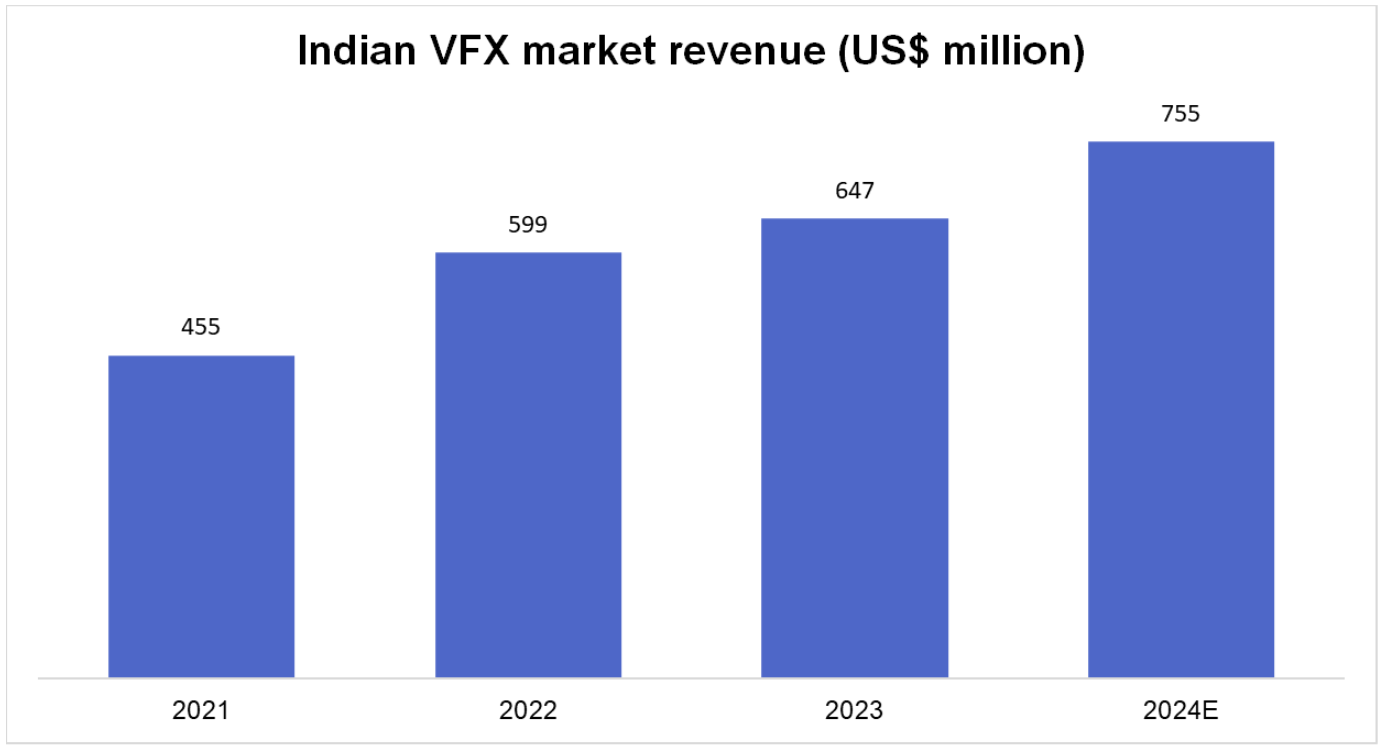SEARCH
RECENT POSTS
Categories
- Agriculture (30)
- Automobiles (18)
- Banking and Financial services (33)
- Consumer Markets (48)
- Defence (6)
- Ecommerce (21)
- Economy (67)
- Education (13)
- Engineering (6)
- Exports (21)
- Healthcare (24)
- India Inc. (8)
- Infrastructure (29)
- Manufacturing (27)
- Media and Entertainment (15)
- Micro, Small & Medium Enterprises (MSMEs) (15)
- Miscellaneous (30)
- Perspectives from India (33)
- Pharmaceuticals (4)
- Railways (4)
- Real Estate (16)
- Renewable Energy (17)
- Research and Development (9)
- Retail (1)
- Services (6)
- Startups (15)
- Technology (53)
- Textiles (6)
- Tourism (13)
- Trade (5)
The Rise of VFX Industry in India

- Apr 04, 2025, 09:45
- Media and Entertainment
- IBEF
In today's world, the VFX industry is one of the most vital elements among all forms of entertainment in storytelling, such as movies, television series, and video gaming. The global VFX market is estimated to expand at a CAGR of 10.7% from US$ 15 billion in 2023 to US$ 30 billion by 2030 (according to Markets.us). This significant growth underscores the increasing recognition of VFX's critical role in delivering stunning and immersive experiences across various media. Riding on this dynamic wave, India has emerged as a powerhouse of creative and innovative VFX.
The VFX landscape in India has moved from its humble beginnings to a powerhouse acknowledged for technical excellence and artistic ingenuity over the past 20 years. The studios, which initially were outlets working on smaller-scale animations, have transformed considerably since the early 2000s with locally emerging production houses and ventures with international entities. The Indian VFX market is pegged to be around Rs. 11,400 crore (US$ 1.38 billion) in 2023, with visual effects alone accounting for Rs. 5,400 crore (US$ 647 million). Cost efficiency, rich cultural heritage, informed storytelling and the adoption of cutting-edge technologies, such as Artificial Intelligence (AI) and Virtual Reality (VR), are some major factors contributing to the success. These include notable projects such as ‘Life of Pi’ and ‘The Jungle Book’, which raised India's profile and attracted Hollywood and foreign outsourcing. With creativity and technical innovation, India will be an integrating force to inspire a new generation of visual artists and storytellers.
Current landscape of the VFX industry in India
The Indian VFX industry has grown impressively over the last twenty years to emerge as an important player in the global entertainment industry. The FICCI EY Report, released on March 5, 2024, states that the Indian VFX segment had revenue amounting to Rs. 5,400 crore (US$ 647 million) in 2023, up by 8% from Rs. 5,000 crore (US$ 599 million) in 2022, recording moderate growth. The fact that this growth was possible shows the resilience and adaptability of the industry, amidst recent global challenges, including the 2023 writers' strike in Hollywood, which caused significant disruptions in film and television production worldwide.
As of October 2024, India is home to over 4,000 VFX studios of various sizes and niches. This suggests that the landscape has matured to house a range from large, established firms to boutique studio offerings in the market. The larger, more established players in the active ecosystem are leading studios such as Prime Focus Limited, Yash Raj Films and Red Chillies VFX. Prime Focus Limited is a global player in VFX with a complete suite of services, including visual effects, stereo conversion and animation for the film and television industry. Yash Raj Films, a leading Indian production offers high-quality VFX services in tandem with core filmmaking, while Red Chillies VFX has earned several awards for visual effects in some blockbuster films.

Source - FICCI EY Report 2024, E-Estimated
Talent is another critical factor in the growth of the Indian VFX industry. Since most learning institutions started offering training programs in either animation or visual effects, skilled professionals entered the industry at a constant rate. The skills of these individuals are not confined to only conventional VFX techniques but they are also becoming increasingly adept at frontier technologies, such as AI and Machine Learning (ML). With this increasing skillset amongst the artists and technicians, Indian studios can now compete effectively on a global scale.
Talking about notable projects and collaborations, Indian VFX is doing considerably well on domestic and foreign shores. Indian movie hits such as ‘Animal’, ‘Project K’, ‘Adipurush’, and ‘Salaar’ have been increasingly resorting to VFX, with some productions allocating up to 25% or 30% of the total costs of the projects to visual effects. For example, there are over 4,000 VFX shots in ‘Adipurush’ and over 600 in ‘Salaar’; this depicts an increased usage of visual effects to tell the story. These projects reflect the technical competency of Indian studios as well as hint towards the evolving expectation from the audience for a fine visual experience.
The effect of VFX has also spillover effects in advertising, where the use of computer-generated imagery has become rampant. Advertising agencies are leveraging VFX to create striking campaigns that correspondingly raise brand narratives and consumer engagement. This has contributed an estimated 5% to 10% to the overall VFX revenue, showing that visual effects can be used in various categories beyond traditional film and television. Notable examples include Nike and Jacquemus, who have invoked CGI in their ad campaigns with relative success, fueling demand for VFX services within this area.

Source - Times of India
Factors contributing to growth in the Indian VFX industry
- Technological advancements
Advances in technology have been one of the major causes for the growth of this indusrty in India. Now, studios can deliver top-rated visual effects that tell a story in a visually appealing way. Innovations like cloud-based rendering have made workflows substantially more efficient, allowing for fast and inexpensive production processes. Over 70% of VFX studios now leverage these technologies to facilitate remote collaboration and access powerful computing resources. Furthermore, advancements in motion capture, AI and ML are automating repetitive tasks and improving the realism of animations. For example, the blockbuster film ‘Brahmastra’ featured over 4,500 VFX shots, showcasing the industry's capability to create complex visual experiences that captivate audiences. - Government support
The Government of India has been encouraging growth in the VFX and animation sectors through various initiatives and policy decisions. Setting up the National Centre of Excellence in Animation, Gaming and VFX will target skill development and encourage industry growth. Additionally, there is an incentive scheme from the government on international projects that avail services from India, which reimburses up to 30% on qualified expenditure. In return, it would attract foreign collaborations and develop a competitive lead for India in the global market for VFX. As these incentives are capped at Rs. 150 crore (US$ 18 million) per year, the proactive consideration of the government is very likely to help develop domestic production capabilities substantially and place India as a global hub in VFX. - Global collaborations
Global collaborations are increasingly raising India's profile in the VFX industry, with local studios now working on high-budget international projects. An estimated 70% of the revenue (according to FICCI-EY report) that Indian VFX studios generate is through international partnerships, which bring them not only financial benefits but also much-needed exposure to global standards. Collaboration with major studios, such as Disney and Warner Bros, enabled Indian artists to contribute to films requiring extensive post-production work. This further cements India's position as a key player in the global VFX landscape, with forecasts of a 15% increase in international collaborations by 2025.
Outlook for the VFX industry in India
The VFX industry in India is set for significant growth over the next five to ten years, fueled by technological advancements, a growing talent pool and rising demand for high-quality visual experiences in cinema, television and gaming. With the global VFX market projected to reach US$ 30 billion by 2030 from US$ 15 billion in 2023 (according to market.us), India's creative potential is gaining recognition. Emerging technologies like VR and Augmented Reality (AR) are transforming storytelling, while AI and ML are improving production efficiency. VFX also enhances India’s rich cultural narratives, as seen in successful films like ‘Baahubali’ and ‘RRR.’ To fully realize this potential, stakeholders—including the government, educators and industry leaders—must invest in skills, infrastructure, and innovation, ensuring India solidifies its position as a global leader in the VFX sector and continues to enrich its cultural and economic landscape.
















